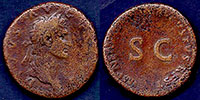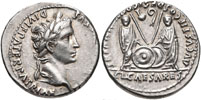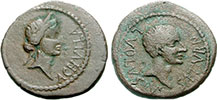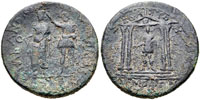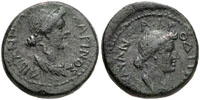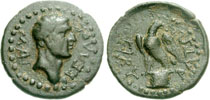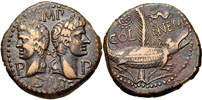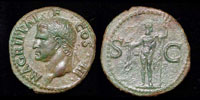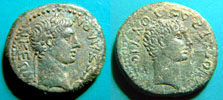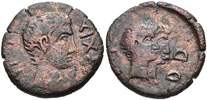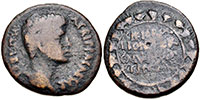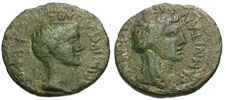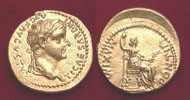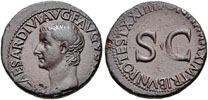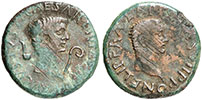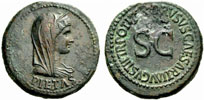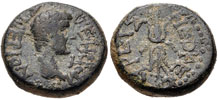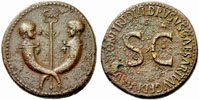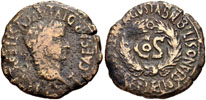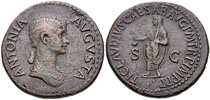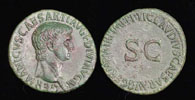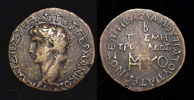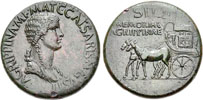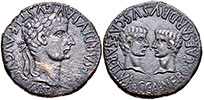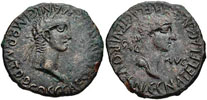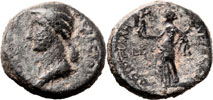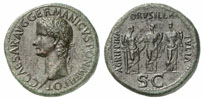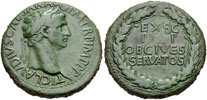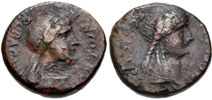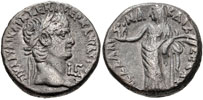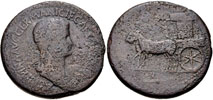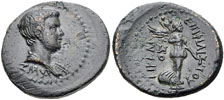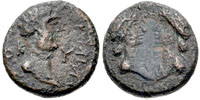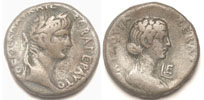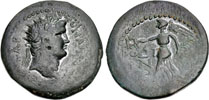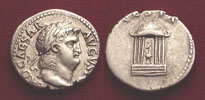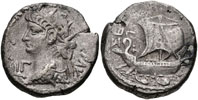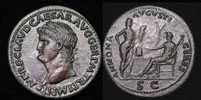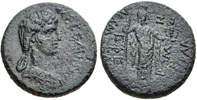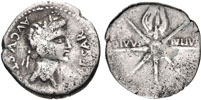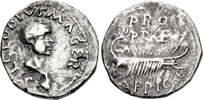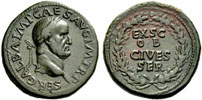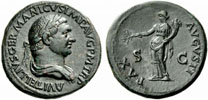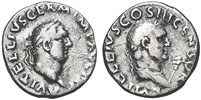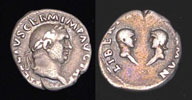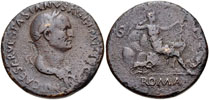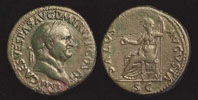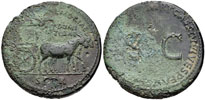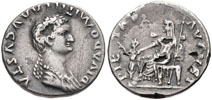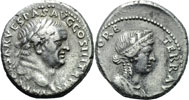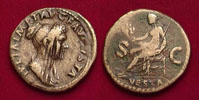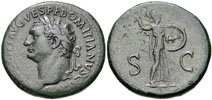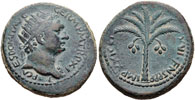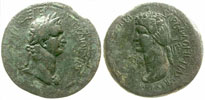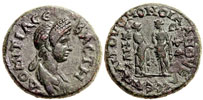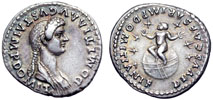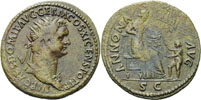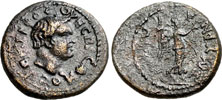(1st century, the 12 Caesars)
Collection L - Now For Sale - Offers Welcome
THE JULIO-CLAUDIANS ( Family Tree )
JULIUS CAESAR [1], 49-44 BC (see Roman Imperatorial coins page)
AUGUSTUS [2], 27 BC - 14 AD
7935. CHOICE AUGUSTUS PORTRAIT BRONZE, 27BC-14AD. AE As. Radiate hd. l./Augustus in curule chair l. Choice EF. Sharply stuck, well centered example. Rare this nice.
9440. EXCELLENT STYLE AUGUSTUS PORTRAIT DENARIUS, Denarius. /Shield within wreath. EF. 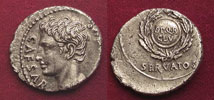
L. VOLUSIUS SATURNINUS, proconsul under Augustus
M. PLAUTIUS SILVANUS, proconsul under Augustus
LIVIA, wife of Augustus, mother of Tiberius
JULIA, daughter of Augustus, step-daughter of Livia, wife of Marcellus, Agrippa and Tiberius, mother of Gaius and Lucius caesars, Agrippa Postumus, Julia the Younger and Agrippina Senior
MARCELLUS, son-in-law and intended heir of Augustus, son of Octavia (sister of Augustus), first husband and cousin of Julia
AGRIPPA, son in-law and intended successor of Augustus, 2nd husband of Julia, father of Gaius and Lucius caesars, Agrippa Postumus, Julia the Younger and Agrippina Senior
7661. AGRIPPA (struck by Caligula). Dupondius, RIC58. /Neptune stg. l. EF. Choice fine style portrait of the famous Roman general.
CAIUS CAESAR, adopted son and intended heir of Augustus, son of Agrippa and Julia
LUCIUS CAESAR, adopted son and intended heir of Augustus, son of Agrippa and Julia
AGRIPPA POSTUMUS, son of Agrippa and Julia
ASINIUS GALLUS, proconsul of Asia and potential successor of Augustus
TIBERIUS [3], 14-37
LUCIUS APRONIUS, proconsul in Africa under Tiberius
DRUSUS (Drusus II, Drusus Minor) b13BC-d23AD, son of Tiberius
LIVILLA, wife of Gaius Caesar and Drusus, daughter of Nero Claudius Drusus and Antonia, sister of Germanicus and Claudius, mother of Tiberius and Germanicus Gemellus and Livia Julia, granddaughter of Livia, Marc Antony and Octavia
TIBERIUS GEMELLUS, son of Drusus and Livilla
TIBERIUS GEMELLUS and GERMANICUS GEMELLUS, sons of Drusus and Livilla
SEJANUS, potential successor of Tiberius
11633. TIBERIUS AND SEJANUS. Pretorian Prefect of Tiberius. AE28, 11.23 g. Mint of Bibilis, Spain, 31 AD. Copper as, RPC I 398, Burgos 196, Vagi 484. Wildwinds RPC 398.1 (this coin). Obverse: TI CAESAR DIVI AVGVSTI F AVGVSTVS; laureate head of Tiberius right. Reverse: MVN AVGVSTA BILBILIS TI CAESARE V L AELIO SEIANO, COS in wreath. Near VF/VF. Very rare and an even rarer example with the name of Sejanus intact. In almost all specimens the name of the famous Pretorian Prefect of Tiberius was obliterated following his execution. Only 19 examples known to RPC. SOLD.
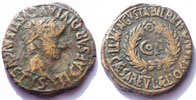
NERO CLAUDIUS DRUSUS, younger brother of Tiberius, husband of Antonia, father of Germanicus, Livilla and Claudius
ANTONIA (aka Antonia Minor or Antonia the Younger), 3rd daughter of Marc Antony and Octavia, wife of Nero Claudius Drusus, mother of Germanicus, Livilla, and Claudius
GERMANICUS, son of Nero Claudius Drusus and Antonia
7667. CHOICE PORTRAIT BRONZE OF GERMANICUS, father of Caligula, AE As, HRIC 3 ($300-$1000). Germanicusí hd. r./Large SC. EF+. Choice example!
AGRIPPINA SENIOR, mother of Caligula, wife of Germanicus
NERO (Nero Julius Caesar Germanicus c. AD 6-AD 30) AND DRUSUS (Drusus III, Drusus Julius Caesar, AD 7-AD 33) CAESARS, sons of Germanicus and Agrippina Senior, brothers of Caligula
CALIGULA [4], 37-41
CAESONIA, fourth wife of Caligula, mother of Drusilla Minor
DRUSILLA MINOR, daughter of Caligula and Caesonia
DRUSILLA MAJOR AND JULIA LIVILLA (with AGRIPPINA JR.), sisters of Caligula, daughters of Germanicus and Agripinna Sr.
CLAUDIUS [5], 41-54
QUINTUS VERANIUS, governor of Lycia (43-48 AD) under Claudius, later governor of Britain in 57 AD.
11632. VERANIUS (under Claudius) Cibyra, RPC 2889. AE 18, 5.28 g. OUHRANIOS; bare head of Veranius? / KIBURATWN; temple with four columns. F. Very Rare. Provenance: Ex CNG. 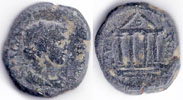
VALERIA MESSALINA, 3rd wife of Claudius, mother of Britannicus and Claudia Octavia, stepmother of Claudia Antonia
AGRIPPINA JR., sister of Caligula, niece and 4th wife of Claudius, mother of Nero
BRITANNICUS, son of Claudius by Messalina
CLAUDIA ANTONIA, daughter of Claudius and Aelia Paetina, half-sister of Britannicus and Claudia Octavia, niece of Sejanus, step-sister of Nero
CLAUDIA OCTAVIA, first wife of Nero, daughter of Claudius and Messalina, sister of Britannicus
NERO [6], 50-68, son of Agrippina Jr., adopted son of Claudius
7940. NERO, 54-68 AD. Sestertius,. /ANNONA AVGVSTI CERES, Annona stg. l., Ceres std. on r., prow behind. Refers to grain supply to Rome. EF. Choice example.
POPPAEA, Augusta, AD 62-65. Second wife of Nero, previously wife of Otho, d. 65 AD, mother of Claudia Neronis
CLAUDIA NERONIS, Augusta AD 63, daughter of Nero by Poppaea, d. aged 3 months 63 AD
STATILIA MESSALINA, Augusta AD 66-68. Third wife of Nero
THE CIVIL WAR PERIOD OF 68-69
VINDEX, 68
CLODIUS MACER, 68
GALBA [7], 68-69
OTHO [8], 69
VITELLIUS [9], 69
LUCIUS VITELLIUS (Vitellius Pater), father of Vitellius
VITELLIUS GERMANICUS AND VITELLIA, son and daughter of Vitellius
JULIUS CIVILIS, rebel 69-70 (Looking for a coin of his. Please contact us if one is available.)
THE FLAVIANS, 69-96 AD
VESPASIAN [10], 69-79
6615. VESPASIAN. AE Sestertius. /Salus std. l. EF.
DOMITILLA THE ELDER, wife of Vespasian, mother of Titus and Domitian and Domitilla the younger. (No coins with her likeness)
DOMITILLA THE YOUNGER (Flavia Domitilla Minor, c. 45 - c. 66, Augusta posthumously), daughter of Vespasian and Domitilla the elder
FLAVIA DOMITILLA III, (Christian Saint), granddaughter of Vespasian and Domitilla the elder, daughter of Domitilla the younger
ANTONIA CAENIS, mistress and de facto 2nd wife of Vespasian
TITUS [11], 69-81
JULIA TITI, daughter of Titus
DOMITIAN [12], 69-96
8603. DOMITIAN, 69-96 AD. Dupondius. /Mars walking l. with Victory and trophy. AEF. Scarce. Beautiful coin. $3250
DOMITIA LONGINA, wife of Domitian
DEIFIED SON OF DOMITIAN, son of Domitian and Domitia who died while a boy
VESPASIAN JUNIOR, adopted son and heir apparent of Domitian
VARIA
